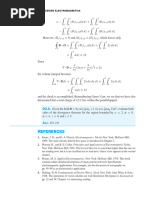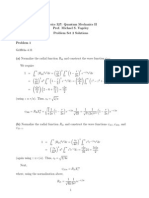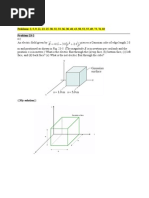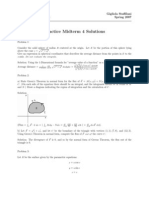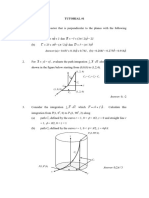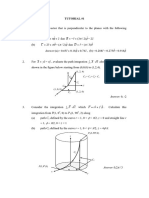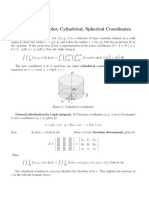EE-311 Ch3 HW Solutions
EE-311 Ch3 HW Solutions
Uploaded by
vimalk017Copyright:
Available Formats
EE-311 Ch3 HW Solutions
EE-311 Ch3 HW Solutions
Uploaded by
vimalk017Original Description:
Copyright
Available Formats
Share this document
Did you find this document useful?
Is this content inappropriate?
Copyright:
Available Formats
EE-311 Ch3 HW Solutions
EE-311 Ch3 HW Solutions
Uploaded by
vimalk017Copyright:
Available Formats
EE-311 Ch3 HW Solutions
Solution 3.4
An electric field in free space is E = (5z 3 / 0 ) aˆ z V/m. Find the total charge contained
within a sphere of 3-m radius, centered at the origin. Using Gauss' law, we set up the
integral in free space over the sphere surface, whose outward unit normal is ar :
2
0E n da =
Q=Ñ 0 5z a z a r (3)2 sin d d
3
0
where in this case z = 3cos and (in all cases) a z ar = cos . These are substituted to
yield
1
Q = 2 5(3)5 cos 4 sin d = −2 (5)(3)5 cos5 |02 = 972
0
5
Solution 3.5
Let D = 4 xya x + 2( x2 + z 2 )a y + 4 yza z C/m2 and evaluate surface integrals to find the total
charge enclosed in the rectangular parallelepiped 0 x 2 , 0 y 3 , 0 z 5 m: Of the
6 surfaces to consider, only 2 will contribute to the net outward flux. Why? First consider
the planes at y = 0 and 3. The y component of D will penetrate those surfaces, but will
be inward at y = 0 and outward at y = 3 , while having the same magnitude in both cases.
These fluxes will thus cancel. At the x = 0 plane, Dx = 0 and at the z = 0 plane, Dz = 0 ,
so there will be no flux contributions from these surfaces. This leaves the 2 remaining
surfaces at x = 2 and z = 5 . The net outward flux becomes:
5 3 3 2
=
0 0
D |x = 2 a x dy dz + D |z =5 a z dx dy
0 0
3 3
= 5 4(2) y dy + 2 4(5) y dy = 360 C
0 0
Solution 3.9
A uniform volume charge density of 80 C/m3 is present throughout the region
8mm r 10mm . Let v = 0 for 0 r 8mm .
a) Find the total charge inside the spherical surface r = 10 mm: This will be
Hayt/Buck, Engineering Electromagnetics, 8/e. ©2012. The McGraw-Hill Companies
2 .010 r 3 .010
Q= 0 .008 (80 10−6 )r 2 sin dr d d = 4 (80 10−6 ) |.008
0 3
= 1.64 10−10 C = 164 pC
b) Find Dr at r = 10 mm: Using a spherical Gaussian surface at r = 10 , Gauss’ law is
written as 4 r 2 Dr = Q = 164 10−12 , or
164 10−12
Dr (10mm) = = 1.30 10−7 C/m 2 = 130nC/m 2
4 (.01)2
c) If there is no charge for r 10 mm, find Dr at r = 20 mm: This will be the same
computation as in part b , except the gaussian surface now lies at 20 mm. Thus
164 10−12
Dr (20mm) = = 3.25 10−8 C/m 2 = 32.5nC/m 2
4 (.02) 2
Solution 3.13
Spherical surfaces at r = 2, 4, and 6 m carry uniform surface charge densities of
20 nC/m2 , −4nC/m2 , and s 0 , respectively.
a) Find D at r = 1, 3and5 m: Noting that the charges are spherically-symmetric, we
ascertain that D will be radially-directed and will vary only with radius. Thus, we
apply Gauss’ law to spherical shells in the following regions: r 2 : Here, no
charge is enclosed, and so Dr = 0 .
80 10−9
2 r 4 : 4 r 2 Dr = 4 (2) 2 (20 10−9 ) Dr = C/m 2
r2
So Dr (r = 3) = 8.9 10−9 C/m2 .
16 10−9
4 r 6 : 4 r 2 Dr = 4 (2) 2 (20 10−9 ) + 4 (4) 2 ( −4 10 −9 ) Dr =
r2
So Dr (r = 5) = 6.4 10−10 C/m2 .
b) Determine s 0 such that D = 0 at r = 7 m. Since fields will decrease as 1/ r 2 , the
question could be re-phrased to ask for s 0 such that D = 0 at all points where
r 6 m. In this region, the total field will be
16 10−9 s 0 (6) 2
Dr (r 6) = +
r2 r2
Requiring this to be zero, we find s 0 = −(4 / 9) 10−9 C/m2 .
Hayt/Buck, Engineering Electromagnetics, 8/e. ©2012. The McGraw-Hill Companies
Solution 3.16
An electric flux density is given by D = D0 a , where D0 is a given constant.
a) What charge density generates this field? Charge density is found by taking the
divergence: With radial D only, we have
1 d D
v = D = ( D0 ) = 0 C/m3
d
b) For the specified field, what total charge is contained within a cylinder of radius
a and height b , where the cylinder axis is the z axis? We can either integrate the
charge density over the specified volume, or integrate D over the surface that
contains the specified volume:
b 2 a D0 b 2
Q=
0 0 0
d d dz = D0 a a a d dz = 2 abD0 C
0 0
Solution 3.17
A cube is defined by 1 x, y, z 1.2 . If D = 2 x 2 ya x + 3x 2 y 2a y C/m2 :
a) apply Gauss’ law to find the total flux leaving the closed surface of the cube. We
call the surfaces at x = 1.2 and x = 1 the front and back surfaces respectively,
those at y = 1.2 and y = 1 the right and left surfaces, and those at z = 1.2 and z = 1
the top and bottom surfaces. To evaluate the total charge, we integrate D n over
all six surfaces and sum the results. We note that there is no z component of D ,
so there will be no outward flux contributions from the top and bottom surfaces.
The fluxes through the remaining four are
1.2 1.2 1.2 1.2
D n da = 11 414 42(1.2)
=Q=Ñ
2 4 4 4 3 1 1 4 14 4 2 4 4 4 3
y dy dz + − 2(1)2 y dy dz
2
front back
1.2 1.2 1.2 1.2
+ − 3x (1) dx dz + 3x (1.2) dx dz = 0.1028C
2 2 2 2
11 4 14 4 2 4 4 4 3 11 4 14 4 2 4 4 4 3
left right
b) evaluate D at the center of the cube: This is
D = 4 xy + 6 x 2 y = 4(1.1)2 + 6(1.1)3 = 12.83
(1.1,1.1)
c) Estimate the total charge enclosed within the cube by using Eq. (8): This is
Q B D |center v = 12.83 (0.2)3 = 0.1026 Close!
Hayt/Buck, Engineering Electromagnetics, 8/e. ©2012. The McGraw-Hill Companies
Solution 3.19
A spherical surface of radius 3 mm is centered at P(4,1,5) in free space. Let
D = xa x C/m2 . Use the results of Sec. 3.4 to estimate the net electric flux leaving the
spherical surface: We use B Dv , where in this case D = ( / x) x = 1C/m3 . Thus
4
B (.003)3 (1) = 1.13 10−7 C = 113nC
3
Solution 3.25
Within the spherical shell, 3 r 4 m, the electric flux density is given as
D = 5(r − 3)3 ar C/m2
a) What is the volume charge density at r = 4 ? In this case we have
1 d 2 5
v = D = 2
(r Dr ) = (r − 3) 2 (5r − 6) C/m3
r dr r
which we evaluate at r = 4 to find v (r = 4) = 17.50 C/m3 .
b) What is the electric flux density at r = 4 ? Substitute r = 4 into the given
expression to find D(4) = 5 ar C/m2
c) How much electric flux leaves the sphere r = 4 ? Using the result of part b , this
will be = 4 (4)2 (5) = 320 C
d) How much charge is contained within the sphere, r = 4 ? From Gauss’ law, this
will be the same as the outward flux, or again, Q = 320 C .
Solution 3.29
In the region of free space that includes the volume 2 x, y, z 3 ,
2
D= 2
( yz a x + xz a y − 2 xy a z ) C/m 2
z
a) Evaluate the volume integral side of the divergence theorem for the volume
defined above: In cartesian, we find D = 8xy / z 3 . The volume integral side is
now
Hayt/Buck, Engineering Electromagnetics, 8/e. ©2012. The McGraw-Hill Companies
3 3 3 8 xy 1 1
vol D dv = 2 2 2 z 3
dxdydz = (9 − 4)(9 − 4) − = 3.47 C
4 9
b) Evaluate the surface integral side for the corresponding closed surface: We call
the surfaces at x = 3 and x = 2 the front and back surfaces respectively, those at
y = 3 and y = 2 the right and left surfaces, and those at z = 3 and z = 2 the top
and bottom surfaces. To evaluate the surface integral side, we integrate D n over
all six surfaces and sum the results. Note that since the x component of D does
not vary with x , the outward fluxes from the front and back surfaces will cancel
each other. The same is true for the left and right surfaces, since D y does not vary
with y . This leaves only the top and bottom surfaces, where the fluxes are:
3 3−4 xy 3 3 −4 xy 1 1
D dS = 2 2
Ñ 2
dxdy −
2 2 2
dxdy = (9 − 4)(9 − 4) − = 3.47 C
4 9
1 4 4 23 4 4 3 1 4 4 22 4 4 3
top bottom
Hayt/Buck, Engineering Electromagnetics, 8/e. ©2012. The McGraw-Hill Companies
You might also like
- Solution Manual Applied Partial Differential Equations 5th Edition by HabermanDocument7 pagesSolution Manual Applied Partial Differential Equations 5th Edition by Habermanindustriale82No ratings yet
- Sheet 3 SoluttionDocument9 pagesSheet 3 SoluttionShima ElsofyNo ratings yet
- Ch3 ExtraDocument5 pagesCh3 ExtraAli RajabNo ratings yet
- EMTDocument5 pagesEMTnuttapong.chuaNo ratings yet
- Soluciones A Problemas de Mecaninca CuanticaDocument7 pagesSoluciones A Problemas de Mecaninca CuanticaIván GarcíaNo ratings yet
- CH 3Document15 pagesCH 3Gennelyn Lozano IsraelNo ratings yet
- Chap3 William HaytDocument15 pagesChap3 William HaytM Zafeer KhanNo ratings yet
- HWSolution1Document4 pagesHWSolution1fourtime004No ratings yet
- Solution 2 AntennaDocument7 pagesSolution 2 Antennaabdulwahab12100% (1)
- 1 Method of Images: Plane BoundaryDocument25 pages1 Method of Images: Plane BoundaryRoshan ShresthaNo ratings yet
- Chapter 03 Drill Solutions Engineering Electromagnetics 7th Edition - William H. Hayt, John A. Buck PDFDocument3 pagesChapter 03 Drill Solutions Engineering Electromagnetics 7th Edition - William H. Hayt, John A. Buck PDFfaqihNo ratings yet
- Fundamentals Antennas and Propagation SoDocument7 pagesFundamentals Antennas and Propagation SomishrarahikaNo ratings yet
- Method of Images Greens JacksonDocument24 pagesMethod of Images Greens Jacksonibn_rafi100% (1)
- EEC130A: Practice Problems For Midterm 2: Instructor: Xiaoguang "Leo" Liu (Lxgliu@ucdavis - Edu) Updated: Mar. 6 2012Document11 pagesEEC130A: Practice Problems For Midterm 2: Instructor: Xiaoguang "Leo" Liu (Lxgliu@ucdavis - Edu) Updated: Mar. 6 2012M Erizky SyaputraNo ratings yet
- Lec Week10Document4 pagesLec Week10Haripriya RadhakrishnanNo ratings yet
- Vector Calculus: EELE 3331 - Electromagnetic IDocument31 pagesVector Calculus: EELE 3331 - Electromagnetic IYahya AlmolikiNo ratings yet
- Lecture Notes - Week 3Document18 pagesLecture Notes - Week 3Nawin RaNo ratings yet
- Assignment 4 (Vector Calculus)Document6 pagesAssignment 4 (Vector Calculus)Shail BajpaiNo ratings yet
- Vector CalculusDocument158 pagesVector CalculusTuan JalaiNo ratings yet
- SP 23Document39 pagesSP 23Mike Mancini0% (1)
- Research PaperDocument13 pagesResearch PaperScott JacksonNo ratings yet
- Math Refresher 1 (October 2024)Document2 pagesMath Refresher 1 (October 2024)andreijoshuaavelinoNo ratings yet
- Iitjee Advanced 2013 Question Paper 2 With SolutionsDocument39 pagesIitjee Advanced 2013 Question Paper 2 With SolutionssanjayjainitmNo ratings yet
- Practice Midterm 4 SolnDocument3 pagesPractice Midterm 4 Solnkerokero_19198448No ratings yet
- Method I - Stokes' Law: AppendicesDocument4 pagesMethod I - Stokes' Law: AppendicesMartim LemeNo ratings yet
- Stocks TheoramDocument5 pagesStocks Theoramarpit sharmaNo ratings yet
- Tutorial#1Document2 pagesTutorial#1Saumik HeronNo ratings yet
- Tutorial#1Document2 pagesTutorial#1Mutaza MazlanNo ratings yet
- Chapter03 7th SolutionDocument11 pagesChapter03 7th SolutionRafael Alexandre N PurificacaoNo ratings yet
- Practice Midterm SolutionsDocument27 pagesPractice Midterm Solutionsplaidmonster10No ratings yet
- принстон 3 PDFDocument30 pagesпринстон 3 PDFLumpalump 300ftNo ratings yet
- 2.7 Aerosols and Coagulation: 2.7.1 Brownian Diffusion of ParticlesDocument8 pages2.7 Aerosols and Coagulation: 2.7.1 Brownian Diffusion of ParticlesMJ SumalinogNo ratings yet
- Curvature 24 Nov 2008Document2 pagesCurvature 24 Nov 2008Peter FisherNo ratings yet
- Solutions To Tutorial 5 (Week 6) : Lecturers: Daniel Daners and James ParkinsonDocument12 pagesSolutions To Tutorial 5 (Week 6) : Lecturers: Daniel Daners and James ParkinsonTOM DAVISNo ratings yet
- Surface IntegralsDocument18 pagesSurface Integralsmasyuki1979No ratings yet
- Cap. 32 PDFDocument75 pagesCap. 32 PDFwallaNo ratings yet
- Griffith ElmagDocument6 pagesGriffith ElmagnadiaNo ratings yet
- Notes On Vector CalculusDocument10 pagesNotes On Vector CalculusYukiNo ratings yet
- 1120uf EE-EMTDocument9 pages1120uf EE-EMTcena4857No ratings yet
- 1 Introduction The Spherical Collapse: Lectures On Effective Field Theory of Large Scale StructureDocument24 pages1 Introduction The Spherical Collapse: Lectures On Effective Field Theory of Large Scale StructureMatejaBoskovicNo ratings yet
- Jest 2014Document6 pagesJest 2014Kay r starNo ratings yet
- Outline of Solutions To Homework 1Document3 pagesOutline of Solutions To Homework 1Michel AndradeNo ratings yet
- Problem 4.5 (A) (B) (C) (D)Document11 pagesProblem 4.5 (A) (B) (C) (D)Steve HoNo ratings yet
- Jackson Electrodynamics Chapter 1 SolutionDocument13 pagesJackson Electrodynamics Chapter 1 SolutionHayanNo ratings yet
- Triple SubstitutionDocument4 pagesTriple SubstitutionTinaNo ratings yet
- VC 4Document5 pagesVC 4mjftesttrialNo ratings yet
- MAE 3233-Stillwater - HW 2 Solution - Radiation CH 12 Ver 03Document12 pagesMAE 3233-Stillwater - HW 2 Solution - Radiation CH 12 Ver 03Yep IdidthisNo ratings yet
- Tutorial 4Document2 pagesTutorial 4nurumairahNo ratings yet
- Jee Main 2022 26 July Morning Shift Question Paper With Solutions PDFDocument26 pagesJee Main 2022 26 July Morning Shift Question Paper With Solutions PDFALEKHYA KANCHIBHATLANo ratings yet
- Civil Engg 06 02 21 6 00 PM Shift 2 85Document23 pagesCivil Engg 06 02 21 6 00 PM Shift 2 85u9830120786No ratings yet
- Neet Question Paper 2021 Code O1Document71 pagesNeet Question Paper 2021 Code O1Deev SoniNo ratings yet
- مثال فصل 6Document10 pagesمثال فصل 6mohammadNo ratings yet
- Chapter6 7thDocument14 pagesChapter6 7thMuhammad RidwanNo ratings yet
- 10+2 Level Mathematics For All Exams GMAT, GRE, CAT, SAT, ACT, IIT JEE, WBJEE, ISI, CMI, RMO, INMO, KVPY Etc.From Everand10+2 Level Mathematics For All Exams GMAT, GRE, CAT, SAT, ACT, IIT JEE, WBJEE, ISI, CMI, RMO, INMO, KVPY Etc.No ratings yet
- Trigonometric Ratios to Transformations (Trigonometry) Mathematics E-Book For Public ExamsFrom EverandTrigonometric Ratios to Transformations (Trigonometry) Mathematics E-Book For Public ExamsRating: 5 out of 5 stars5/5 (1)
- Manual HandlingDocument23 pagesManual Handlingvimalk017No ratings yet
- Safety in Inspection & Testing-2018Document12 pagesSafety in Inspection & Testing-2018vimalk017No ratings yet
- Heat Stress: Body's Thermal RegulationDocument30 pagesHeat Stress: Body's Thermal Regulationvimalk017No ratings yet
- Accident Prevention Manual For Business & Industry:: Engineering & Technology 13th EditionDocument60 pagesAccident Prevention Manual For Business & Industry:: Engineering & Technology 13th Editionvimalk017No ratings yet
- Basic Philosophy of AccidentDocument49 pagesBasic Philosophy of Accidentvimalk017No ratings yet
- 4 Safety ManagementDocument52 pages4 Safety Managementvimalk017No ratings yet
- ColdenvironmentDocument27 pagesColdenvironmentvimalk017No ratings yet
- 1 Explosive ActDocument22 pages1 Explosive Actvimalk017No ratings yet
- 5 SMPV RulesDocument16 pages5 SMPV Rulesvimalk017No ratings yet



